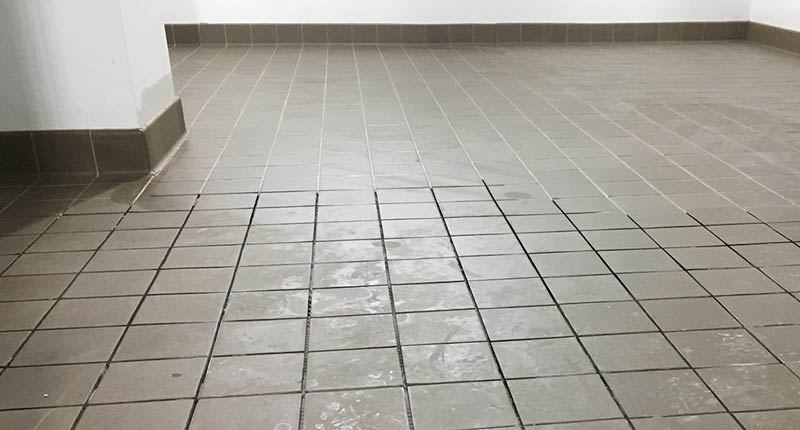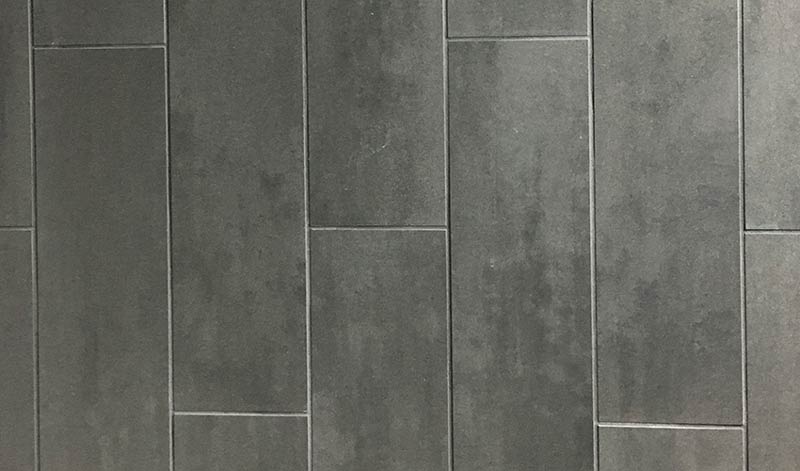Water, cement, and sand have consistently formed the foundation of civilizations. However, as humans progress, we are constantly developing new ways to construct things. Grout is a dense fluid that is used as a reinforcement in existing structures. It fills gaps and seals the joints between tiles. Differing from mortar, grout has a low viscosity and lack of lime, which makes it thinner and easier to work with.
While tile mortar is used to secure tiles to the substructure, grout fills the spaces in between the tiles. Grout comes in a variety of finishes and materials, from sanded to polymer and furan. Additionally, when selecting tile grout, several things must be taken into consideration like:
- The type of tile or stone being used.
- The space in which the tile is installed (locker room, commercial kitchen, toilet, etc.)
- Activities on tile that might affect your choice (foyer vs. kitchen)
- Any environment it may be exposed to (grease, heat, steam)

Joint Size
The American National Standards Institute (ANSI) states that there is generally no specific standard for the size of a grout joint, but notes:
Nominal centerline of all joints should be straight and of even width with due allowances for hand-molded or rustic tiles.
Some relevant questions to ask before installation include:
- How big is the tile?
- What amount of variation is there between tiles?
- Where is it being used?
- Is the surface level?
- Can it be easily scratched?
- Are the edges of the tile linear or hand-molded?
Ultimately, the designer should choose the grout joint that best fits the scenario. It should be noted that the tighter the joint, the more variation there will be from tile to tile. A good standard is to avoid any joint smaller than three times the average variation (from tile to tile). Otherwise, the finished product could look irregular.
When selecting the type of grout to use, you have a lot of options, which we discuss below.
Sanded Tile Grout
The top choice for most tiling projects is sanded tile grout. It is comprised of Portland cement with silica sand, inorganic aggregates, and chemicals. Sanded tile grout is more affordable than unsanded grout because sand is a cheaper filler than polymers. It provides a tight lock and makes for a clean finish.
Sanded grout should always be sealed to prevent water from infiltrating the tile and ruining the substrate. It is typically used on tile floors where joints are 1/8” to 3/8” wide. Uses for sanded grout can include:
- Bathroom floor
- Kitchen floor
- Shower pan
- Entryway
Sanded grout means denser joints. It is more affordable than other grouts and allows for a large variation of color. However, keep in mind sanded grout can scratch certain surfaces and is difficult to force into narrow joints. It must always be sealed with a pH-neutral and water-based sealer.
Unsanded Tile Grout
Unsanded tile grout (sometimes called non-sanded) also contains Portland cement and powdered pigments for color. There is no silica aggregate filler in unsanded grout, so it works well with easily scratchable surfaces, like glass, metal, ceramic, marble, and natural stone tiles. It is best used for delicate tiles with thin grout lines, which makes it easier for vertical tile installation.
Joints that are small, ranging from 1/8-inch down to 1/16-inch are best for unsanded tile grout. It works well on installations like:
- Shower wall
- Bathroom wall
- Polished or honed stone
- Rectified tile
Unsanded tile grout means less slump on vertical surfaces. Grout sealing is typically not required to finish the job. Keep in mind, unsanded grout is more expensive than sanded and you have fewer choices of color. Additionally, it’s not the best for wide seams due to the viscosity.
Epoxy Tile Grout
Epoxy tile grout is one of the toughest and most sustainable on the market. Unlike sanded or cementitious grout, it is comprised of epoxy resins and a filler powder. This makes it strong, durable, and virtually stain proof. At times, the epoxy bond between tiles is stronger than the tiles themselves. The material can even be impregnated with Teflon.
Epoxy can increase flexibility for joint widths of up to 1 1/4 inches and is best used for projects with:
- Heavily trafficked areas like entryways, hallways, and foyers
- Harsh conditions exposed to grease and acid, like restaurant kitchens
- Kitchen counters and backsplashes
- Any type of flooring you want to protect
The newest types of epoxies contain detergents in the hardeners. This makes for a quick cleanup with water and vastly improved workability. Unlike cement-based grout with the shelf life of a year, epoxy grout can last forever when stored correctly.
Although the strength of epoxy grout is incomparable, there are some downsides. Many installers are not comfortable using the material compared to cementitious grout. It is much more difficult to shape and slope. Additionally, if the job is not done right, the appearance can seem plastic. Porous stone or tiles should be sealed prior to grouting since epoxy grout tends to discolor porous surfaces.
Polymer Tile Grout
Differing from an epoxy grout, polymer tile grout ensures color quality. It can come in handy for disguising irregularities in handmade tiles and bridging the joint thickness in some patterned installations. It is considered high-performance and is designed for more demanding spaces.
Polymer tile grout is cement-based with added polymers that are activated once they hit water. The chemical reaction increases the grout’s water, abrasion, and chemical resistance and adds an incredible amount of strength.
Polymer tile grout is a single component material that is completely stain proof. The first generation was made from urethane and the newer types are a form of siliconized acrylic. Urethane allows for manufacturers to make a translucent grout for glass installations and is easier to clean up than acrylic.
Like epoxy, it can be used for joint widths of up to 1 1/4 inches. Acrylic is suitable for smaller joints, up to 1/8-inch. Polymer grout can benefit projects like:
- High-traffic residences
- Commercial spaces
- Kitchen counters and backsplashes
- Entryways
This type of grout not only offers better color consistency, but also resistance to efflorescence (the salty look of cement products), which is a common problem with cementitious grout. Polymer tile grout should never be used with pebble tile, be submerged, or be exposed to steam.
Furan Tile Grout
Furan tile grout is similar to an epoxy except it is made of polymers of fortified materials that are highly chemical-resistant. There is no water in this type of installation and the system is comprised of two components. Furans contain a furan resin and a filler powder with an acid catalyst. This is what causes the resin to cure. It is a chemical reaction that forms through heat.
The tile surface can be smooth or abrasive, but it must all be treated with a wax coating to protect from staining. Unlike cement-based grout, Furan can fill small spaces and thus can be used for joints spaces like an epoxy or polymer. It works best on jobs like:
- Brick Pavers
- Quarry tile
- Industrial projects like meat-packing plants, warehouses, and laboratories
- Areas exposed to high levels of chemicals and/or grease
Although this is one of the strongest tile grouts on the market, installation can be expensive and dangerous. Precautions should be made to avoid breathing in the vapors and special skills are required for the job. Furan can only be installed in temperatures between 60 and 90 degrees Fahrenheit, so this can make for a very particular type of project.
Grout Color Selection
The color of grout is not always a simple thing to manage. There are a lot of variables that can alter the design aesthetic of the job. The unevenness of color can be subjective and certain grouts are easier to work with than others.
When it comes to color selection, there are generally three main approaches:
- Contrasting — opposing colors like white grout with dark tile
- Harmonizing — same colors like blue grout with blue tile
- Neutral — a shade of white or grey all around

Since most grout is cement based, the majority of it will eventually turn a grey color over time. This means that medium greys and beiges are the best colors to work with if you want to preserve the design. Bold colors and bright blacks and whites will fade over time and change the overall color of the installation.
Be careful using very light colors like white since it tends to show dirt more than neutral or darker colors.
Tile Grout Sealers
When a grout is porous, it must be sealed to maintain the quality of the job. A grout sealer is a water-based or solvent-based sealant that is applied over dried grout to protect it from water, oil, and acid-based materials. Cement-based grout always requires a type of sealant to protect the finish.
There are two types of tile grout sealers that people use: topical (membrane-forming) and penetrating. Topical can be prone to peeling and can get cloudy if residual moisture pushes to the surface. Penetrating sealers continue to breathe after soaking into the tile and are often the preferred method.
Sealers can also come in the form of an additive. These are mixed with the grout before installation and form an integral protection from stains.
Caulk
There are certain instances where caulk should be used in place of grout. Technically speaking, anytime there is a change in backing surface or substrate, caulk should be used so the surfaces can freely move. This includes wall joints and the joints between walls and floors. Caulk is typically dispensed at inside corners and anywhere the tile meets another material, like a bathtub.
Grout can crack when there is movement in the walls, floors, or countertops. This inevitably allows moisture in, which can cause structural problems in certain places. Although grout cannot hide corner cuts as efficiently as caulking, it is often used by installers because:
- Caulk does not match the grout color (or the aging process will cause a mismatch).
- Grout needs less maintenance than caulk
- Mold grows more easily on caulk (except for those treated with mildewcide).
- Acrylic caulks breakdown in wet applications that are horizontal (urethane, silicone, and multi-polymer are better choices).
Although caulk is not good for permanent repairs, it can provide a quick temporary solution until a proper repair can be made.
The tools and materials at our disposal to build innovative and efficient developments continue to grow. Understanding what is available and knowing the best tile grout for the job is part of the battle. Do your research and it will ensure optimal performance on every tiling job you oversee.


